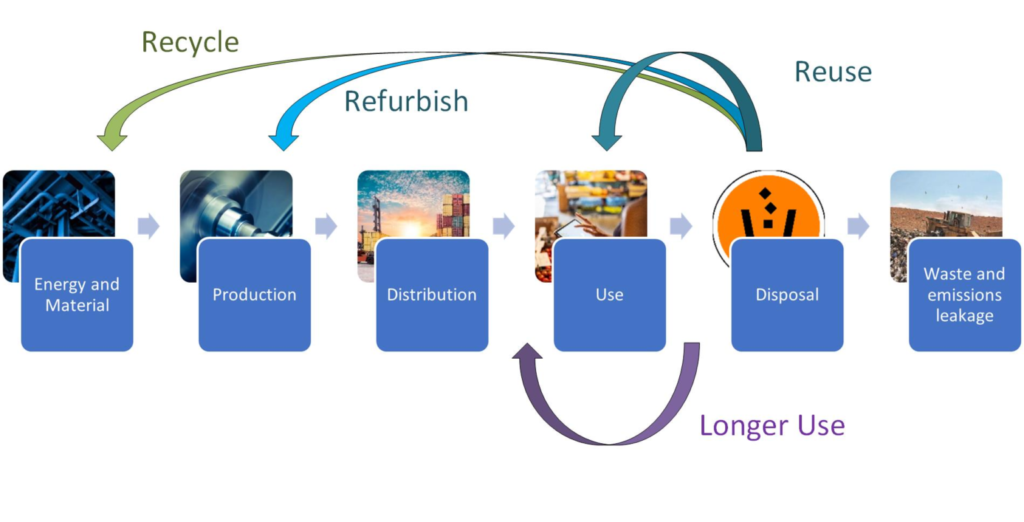Your cart is currently empty!

Marketing a Circular Economy
Introduction
Companies and Consumers realise that their actions directly impact the environment. Waste driven environmental damage can no longer be ignored and wished away.
Consumers also realise that company actions have huge environmental impact. They want to understand and support organisations who take sustainability seriously.
Why? Because the time is now for Consumer Sustainability. Sustainable commerce driven by sustainable marketing. This article explains how Marketing is a fundamental enabler of changing consumer behaviour.
How to normalise sustainable marketing and consumption? Read on for my approach.
Circular economy
The concept of a circular economy puts sustainable marketing into context. The circular economy is a model for developing a more sustainable economy. Its aim is to:
- Eliminating waste and pollution,
- Circulating products and materials, and
- The regeneration of nature

As shown above there are four actions
- Longer use
- Reuse
- Refurbish
- Recycle
These actions are tools for achieving the 3 goals of a circular economy. However, these goals are massive undertakings. For example, there are projections for Five billion phones to be thrown away in 2022. This is just one of many instances of the huge nature of the sustainable challenge.
Marketing propositions require products or services. Sustainable marketing propositions also require an underlying sustainable capability. For example, a proposition rewarding reuse requires the sustainable capability of:
- Older replacement components, or
- Backwardly compatible app-store applications, or
- Additional Customer budget for discounts and benefits
Remember, sustainable marketing is there to promote the use of sustainable capabilities. As the key influencer of people’s behaviour Marketing is an essential enabler of this new era. As well as talking the talk organisations need to walk the walk.
Targeted marketing communications should be proactive to fully prepare the customer for the sustainable options available to them. Reactive communications are less effective. For example, the customer would be less motivated to take the necessary steps towards sustainability once they had purchased a new product. Indeed, in most cases the aim is to prevent the customer purchasing new products and use what they already have.
Longer Use
Customers should be persuaded to use their devices longer, and to opt for higher quality and durable products which have a longer shelf-life. Product release cycles should also be extended to include significant and radical advancements.
Sustainable marketing
- Promote complementary services such as apps.
- Provide maintenance tips and how-to guides
Sustainable capability
- Focus on quality, maintainability, and durability
- Extended product release cycles
- Extended support for older models
- Capture usage data
Reuse
Customers should be persuaded to resale or donate their devices. The most convenient and fastest ways of achieving this should be communicated.
Sustainable marketing
- Provide discounts and other incentives to resale to approved resellers with free pickup and delivery
- Provide discounts and other incentives to donate to approved charities with free pickup and delivery
Sustainable capability
- Provide free or cheap pick-up and delivery options for donations and resales
- Form partnerships with resellers and charities to monitor transactions
Refurbishment
Like re-use, refurbished products can be made to look and operate as new products with minor repairs and maintenance. This maintenance work is usually carried out by certified partners or the manufacturer. The marketing aim should be to get customers to purchase refurbished products.
Sustainable marketing
- Offer steep discounts on refurbished products for existing customers in upsell or cross-sell opportunities
- Promote refreshment partners based on product usage and tenure
Sustainable capability
- Create marketplace for refurbishment resellers
- Provide consultation on refurbishment to partners
Recycling
Provide clear communication on what is recyclable. Provide guidance to make it easier for the manufacturer to recycle products. This should be the default option with landfills being the exception.
Sustainable marketing
- Offer favourable discounts on future purchases on products which cannot be refurbished
- Clearly communicate how to prepare products for recycling
Sustainable capability
- Products made with easily recyclable material
- An established network or recycling partners
- Easy to use pick service
- Proximity to recycling centres
Mobile Phone Maker Example
Putting ourselves in the consumer’s shoes: if you have purchased a phone, there is a high chance you would have registered the phone with the manufacturer. Great, now the manufacturer can up-sell newer models or cross-sell apps. They can also,
- Give you the best deals with trade-ins.
- Provide you with clear instructions on how to maintain the phone
By proactively encouraging the customer to behave with sustainability in mind they will eventually change default behaviour. One of the core principles of sustainable marketing is normalising sustainable behaviour.
Trade-in options should be heavily encouraged by manufacturers of all electronic products, because manufacturers know their products best and so should be the best recyclers.
Have Apple or Samsung proactively offered you great trade-in deals for your old iPad or Samsung Galaxy tab? For example, 10%, 30% or 50% the cost of your next tablet purchase.
Next Best Action
I haven’t yet mentioned Next Best Action (NBA) marketing. Indeed, sustainable marketing is technology neutral. However Next Best Action is a natural home to deliver such communication. It enables the messages to be sent consistently and relevantly in an “always on” mode of execution. “Always-on” reflects the need to normalise sustainable behaviour by presenting the message at every relevant and timely opportunity.
Summary
The circular economy concept has been around for a long time. However, it is now being reported upon and discussed more and more. This is a reaction to the worsening state of levels of planetary pollution. Landfills also consume land which is becoming more and more precious.
Capturing data related to sustainability capability usage informs companies and consumers of their progress in promoting them. Such data will be become a critical KPI in recognising sustainable organisations and will be used by savvy brands as a key motivator for consumer loyalty.
Ultimately a circular economy will mean less production. And what is produced should be highly durable, high quality and recyclable. The measure for growth will place sustainability as a critical indictor. This is currently happening – slowly. The rate of change will eventually be exponential.
Organisations should prepare now for this new reality by investing the sustainability capabilities. They should also invest in promoting those capabilities to their audience, driving loyalty for the future amongst their customer base.
Leave a Reply